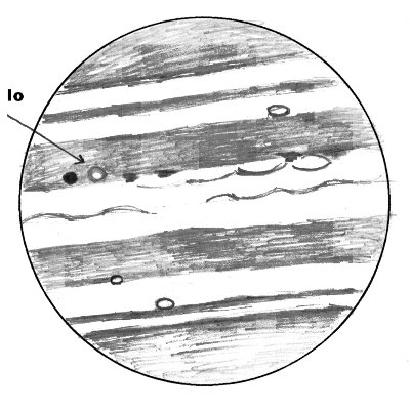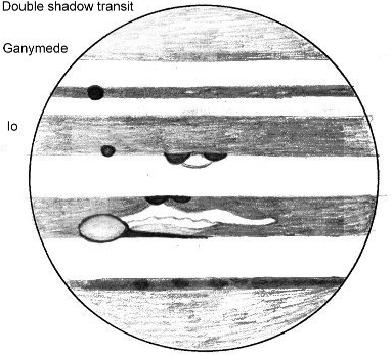Nomenclature of Jovian Features
Paul Morow
The drawings of telescopic observations included with this article were done by Paul Morow and illustrate some of the features to which he refers.
On the night of 2/27/03 I had the opportunity to do some high-powered planetary observing with my 155-mm f/9 refractor. I was able to observe Saturn up to 350x and Jupiter up to 230x with the good seeing conditions. The images of Jupiter I found to be most intriguing on this night.

Jupiter had a gigantic bright festoon off the bottom of the NEB (Northern Equatorial Belt) inside the EZ (Equatorial Zone). There were two dark knots on the top of the NEB and a couple of white ovals following this gigantic festoon. Also, a very dark raft could be seen within the NTB (North Temperate Belt).

After observing these very intense features I could not help myself from performing a quick sketch of Jupiter. The gigantic bright festoon was the largest I have ever seen, and I have been planetary observing pretty seriously for over 10 years.
The following day I could not get those wonderful Jupiter images out of my mind. After work I started reviewing the nomenclature of the Jovian features from several different sources. After finding the term "garlands" I decided this subject would make an interesting article for our LCAS newsletter. A summary of Jupiter's most common features is listed below.
- Garlands (loop festoons): Dark lines that extend from one end of a bay to the other, enclosing a section of a zone like an island. They commence as a bump at the edge of the belt. Commonly seen on the south edge of the Northern Equatorial Belt and extending into the Equatorial Zone and bending in the following direction. The end may bend right over and rejoin the belt.
- Festoons (bridges): Thin bands of dusky cloud material connecting two belts across the intervening zone. When the connection is not made the resulting curling wisps are called "hooks." Broad, diffuse, vertical festoons are known as "columns."
- Ovals: Light or pale gray colored round or circular objects. The light ovals can be seen on zones or belts and are usually the brightest of the Jovian features. They are often seen in the South Tropical Zone and the South Temperate Zone.
- White Spots: Well-defined round spots much smaller than ovals, even smaller than the shadows of the satellites. Usually found within the North and South Equatorial Belts.
- Granular Spots: Red colored spots that are smaller than satellite shadows.
- Bays: Sharply defined semicircular indentations on the straight edge of a dark belt. Small, semi-circular examples are known as "notches."
- Protrusions and Indentations: Dark or light irregularities on the edges of the cloud belts.
- Knots: Thickened sections of an otherwise thin cloud belts.
- Rifts: Bright sharply defined linear features lying at an angle of 45 to 60o on a dark belt extending from both edges so than the adjacent zones are joined.
- Rafts: Short straight dark linear features usually seen in the North Tropical Zone just separated from the edge of the North Equatorial Belt. They look like a short stroke drawn with a pencil.
- Bars: Short thick segments, thicker than rafts, usually found in belt rather than zones. During disturbances bars may have an orange or reddish color.
- Condensations: Minute, well-defined dark spots usually found in belts. When they are long and narrow they are referred to as "rods."
- Nodules: The bright counterparts of condensations. When they are elongated they are known as "streaks."
The large festoon I observed on Jupiter along the south edge of the Northern Equatorial Belt that extending into the Equatorial Zone is actually called a "garland." I have never heard this term used to describe a disturbance on Jupiter before, so I started reviewing some of my past Jupiter sketches for garlands. I found that I had indeed witnessed such disturbances years ago, but never such a large event. There is always something new to explore and learn about in our night sky.
For further reading here are a few of my personal favorite references for planetary observing.
Atlas of the Planets (1980); by Paul Doherty
The Planetary Observer's Handbook (1994); by Fred W. Price
Introduction to Observing and Photographing the Solar System (1988); by Dobbins, Parker, and Capen
Published in the May 2003 issue of the NightTimes




